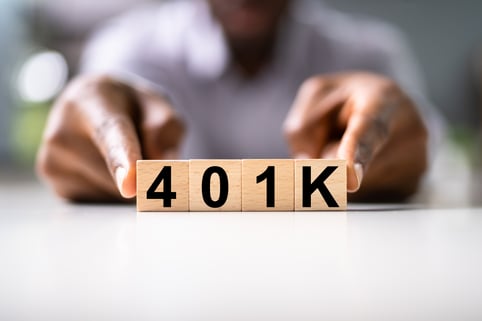![]() Keith's Note: "The Boeing 401(k) Retirement Plan provides multiple ways to save and invest for your future, from Pretax and Roth contributions to Catch-Up and Aftertax options. With company matching, student loan matching, and a range of investment choices—including Target Date, Index, and Actively Managed Funds—you have tools to build a retirement strategy that fits your goals, risk tolerance, and timeline. Planning how to invest, diversify, and eventually withdraw these assets can make a meaningful difference in your long-term financial security." - Keith Demetriades, CFP®, CKA® | Financial Advisor Specializing in Boeing Retirees.
Keith's Note: "The Boeing 401(k) Retirement Plan provides multiple ways to save and invest for your future, from Pretax and Roth contributions to Catch-Up and Aftertax options. With company matching, student loan matching, and a range of investment choices—including Target Date, Index, and Actively Managed Funds—you have tools to build a retirement strategy that fits your goals, risk tolerance, and timeline. Planning how to invest, diversify, and eventually withdraw these assets can make a meaningful difference in your long-term financial security." - Keith Demetriades, CFP®, CKA® | Financial Advisor Specializing in Boeing Retirees.
The Boeing Company 401(k) Retirement Plan is a savings and investment vehicle designed to help employees prepare for retirement. It provides a selection of investment funds and financial planning tools to assist participants in building their Real Wealth.
Before January 1, 2022, the Boeing Company 401(k) Retirement Plan was called the Voluntary Investment Plan (VIP).
Are You Eligible For a Boeing 401(k)?
- A nonunion Boeing employee or an employee represented by a union that currently participates in the plan.
- Paid directly through Boeing’s U.S. payroll department.
- Not on layoff or an unpaid leave of absence.
Boeing 401(k) Contribution Types
Pretax: Contributions that are deducted from your paycheck before federal and state income taxes are calculated. While these contributions reduce your taxable income, they are still subject to FICA and Medicare taxes and the IRS elective deferral limit. Future withdrawals are considered taxable income.
Roth: Contributions that are deducted from your paycheck after federal and state income taxes have been withheld. Roth contributions are subject to FICA and Medicare taxes, but distributions are generally tax-free after you have met the five-year aging requirement and turned age 59 ½.
- In-Plan Roth Conversions: You can convert Pretax and/or Aftertax existing balances in your Boeing 401(k) account into Roth contributions.
Aftertax: Contributions that are deducted from your paycheck after federal and state taxes are withheld. Aftertax contributions are subject to FICA and Medicare taxes. Upon withdrawal, only investment earnings are subject to deferral and state income taxes.
Spill-Over: If your combined Pretax and Roth contributions reach the IRS Elective Deferral Limit (see below) before the end of the calendar year, your contributions will automatically "spill over" into Catch-Up contributions (if applicable) until you reach the Catch-Up contributions limit. Contributions in excess of the Catch-Up limit go into Aftertax contributions for the remainder of the year.
Catch-Up: If you are age 50 or older by the end of the calendar year, you are eligible to make additional "catch-up” contributions beyond the IRS Elective Deferral Limit for Pretax and Roth contributions (see below).
Rollover Contributions: You can roll over eligible amounts from another employer's qualified retirement plan (including Pretax, Roth, and Aftertax funds) or a traditional IRA (Pretax funds only) into your Boeing 401(k). Roth IRAs or IRAs with Aftertax/nondeductible contributions are not accepted for rollovers.
What Are The Contribution Limits?
Elective Deferral Limit (for Pretax and Roth Contributions): This limit applies to the total amount of Pretax and Roth contributions you can make. It includes contributions made to the Boeing 401(k) and any other 401(k) plans you might have with other employers. For 2025, the elective deferral limit is $23,500.
Catch-Up Contribution Limit (for Participants Age 50 or Older): If you are age 50 or older by the end of the calendar year, you are eligible to make additional "catch-up” contributions. These contributions are made from your Base Pay and, if applicable, your Incentive Payments. This limit applies to Catch-Up contributions across all your 401(k) plans, including any with unrelated employers. For 2025, if you are age 50 or older, your combined Pretax, Roth, and Catch-Up contribution limit is $31,000.
Overall Employee Contribution Rate: Between 1% and 50% of eligible pay (which includes Base Pay and, if eligible, Incentive Payments). This percentage encompasses your combined Pretax, Roth, Aftertax, and any Catch-Up contributions, up to the IRS limits. All contributions must be made in 1% increments. Between 1% to 100% from Incentive Payments (if eligible). Contributions from Incentive Payments cannot be made as Aftertax Contributions. All contributions must be made in 1% increments.
Annual Additions Limit: For 2025, the total sum of all contributions cannot exceed $70,000. If you are age 50 or older in 2025, the total sum limit is $77,500.
Eligible Compensation Limit: The IRS sets an annual limit on the amount of compensation that can be used to determine your contributions to the Plan and Boeing's contributions. You cannot contribute, nor will Boeing's contributions (like matching funds) consider, any compensation above this limit. This limit is typically adjusted annually by the IRS in late October to account for cost-of-living increases for the upcoming year
How Boeing Matches Your Contributions
Dollar-for-Dollar Match: Boeing will match your contributions dollar-for-dollar on the first 10% of eligible Base Pay and Incentive Pay that you contribute to the Boeing 401(k). This match applies to any Pretax, Roth, and Catch-Up Contributions you make.
True-Up Company Matching Contribution: This contribution is made after the end of the Plan Year to eligible employees who were employed on the last day of the calendar year (or who terminated due to death, layoff, retirement, or disability) to ensure you receive the maximum possible match based on your eligible contributions throughout the year,. This is particularly helpful if your contributions are uneven throughout the year.
Student Loan Match Program: Qualifying student loan payments can count as if they were contributions to the 401(k) Plan for the purpose of calculating the Company Match. This allows you to receive employer contributions even if your focus is on paying down student debt. If you enroll in this program, you will not receive other regular Company Matching Contributions during that Plan Year.
The Student Loan Match Program contributions are made annually and consist of Student Loan Non-Elective Contributions and Supplemental Matching Contributions, which combined cannot exceed the maximum Company Matching Contribution you could have received.
Suspension of Contributions: Taking certain types of withdrawals while employed can lead to a suspension of Company contributions. For instance, if you take a Company Matching Contributions Withdrawal before age 59½, your Company Matching Contributions will be suspended for a six-month period following the withdrawal.
Other Boeing Investment Options
Target Date Funds: Professionally managed, diversified funds tailored for specific retirement dates (see below).
Index Funds: Passively managed funds designed to match or track the performance of a specific market index, such as the S&P 500. They generally have lower investment management fees compared to actively managed funds.
Actively Managed Funds: Professional fund managers actively select and trade individual stocks and bonds with the goal of outperforming certain target benchmarks.
Company Stock Fund (Boeing Stock Fund): This fund primarily invests in common stock of The Boeing Company and a small amount of cash for liquidity. It aims to track the performance of Boeing stock. Participants are strongly cautioned about the importance of diversification and are advised that investing more than 20% of their retirement savings in any single company stock, including the Boeing Stock Fund, may lead to inappropriate diversification and increased risk.
Investment Approaches
Do-It-For-Me (Target Date Funds): A simple, hands-off method for building a diversified portfolio. Select a Target Date Fund that aligns with your anticipated retirement date (e.g., Target Date 2030 Fund for those retiring in or around 2030). Funds are professionally managed across a mix of investments that automatically become more conservative as the target retirement date approaches. Target Date Funds are customized to include factors like average participant savings profiles and pension benefits.
Do-It-Myself: Create your own custom portfolio by selecting from the individual investments available in the Boeing 401(k). This approach requires more time and investment knowledge as you'll need to select, monitor, and adjust your investments as needed.
Real Wealth Questions
If you’re within 5-10 years of retirement from Boeing, these questions matter:
Investment Options
Is your current asset allocation aligned with your risk tolerance and time horizon for withdrawals?
Should you stay in Target Date Funds, build a custom portfolio, or use a managed account?
Are you periodically rebalancing your account to maintain your target allocation?
Are your retirement assets diversified across a variety of accounts?
What are the total operating expenses associated with your account?
Distribution Strategies
What is your withdrawal plan for your Boeing 401(k) after retirement- systematic withdrawals, lump sum, annuity, or IRA rollover?
Have you accounted for required minimum distributions (RMDs) starting at age 73?
What strategies can help you minimize taxes while tapping into your 401(k)?
Rollover Opportunities
Should you roll over your Boeing retirement accounts to an IRA for broader investment flexibility and estate planning?
What are the pros and cons of staying in the Boeing 401(k) after retirement?
Are you aware of tax consequences of rollovers, especially with Roth conversions?
What To Do Next
Your Boeing 401(k) offers powerful tools—multiple contribution types, generous company matching, and flexible investment options—but how you use them determines your long-term outcome. Take time to review your savings rate, investment allocation, and rollover strategy to ensure they support your Real Wealth and your retirement timeline.
If you want help coordinating your contributions, investment choices, and withdrawal plan with your broader retirement goals, connect with Keith Demetriades, CFP®, CKA®, a financial advisor specializing in Boeing retirees, for personalized guidance on your next steps.

Frequently Asked Questions About the Boeing 401(k) Retirement Plan
-
Nonunion Boeing employees and union participants currently in the plan who are paid through Boeing’s U.S. payroll and not on layoff or unpaid leave.
-
You can contribute Pretax, Roth, Aftertax, Catch-Up (if age 50+), and roll over eligible amounts from other qualified plans.
-
Boeing matches dollar-for-dollar on the first 10% of eligible pay. True-Up contributions and the Student Loan Match Program may add additional company contributions.
-
You can choose Target Date Funds, Index Funds, Actively Managed Funds, or the Boeing Stock Fund. Diversification is important to manage risk.
-
Yes. You can leave it in the plan or roll it over to an IRA or another qualified plan, considering investment flexibility, estate planning, and taxes.

